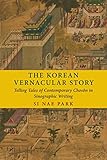The Korean Vernacular Story : Telling Tales of Contemporary Chosŏn in Sinographic Writing / Si Nae Park.
Material type: TextPublisher: New York, NY : Columbia University Press, [2020]Copyright date: ©2020Description: 1 online resource : 5 b&w figuresContent type:
TextPublisher: New York, NY : Columbia University Press, [2020]Copyright date: ©2020Description: 1 online resource : 5 b&w figuresContent type: - 9780231195423
- 9780231551328
- 895.7/002 23
- PL967.3 .P37 2020
- online - DeGruyter
| Item type | Current library | Call number | URL | Status | Notes | Barcode | |
|---|---|---|---|---|---|---|---|
 eBook
eBook
|
Biblioteca "Angelicum" Pont. Univ. S.Tommaso d'Aquino Nuvola online | online - DeGruyter (Browse shelf(Opens below)) | Online access | Not for loan (Accesso limitato) | Accesso per gli utenti autorizzati / Access for authorized users | (dgr)9780231551328 |
Browsing Biblioteca "Angelicum" Pont. Univ. S.Tommaso d'Aquino shelves, Shelving location: Nuvola online Close shelf browser (Hides shelf browser)

|

|

|

|

|

|

|
||
| online - DeGruyter Voices from the Chinese Century : Public Intellectual Debate from Contemporary China / | online - DeGruyter To the End of Revolution : The Chinese Communist Party and Tibet, 1949–1959 / | online - DeGruyter The Chile Pepper in China : A Cultural Biography / | online - DeGruyter The Korean Vernacular Story : Telling Tales of Contemporary Chosŏn in Sinographic Writing / | online - DeGruyter Soft-Power Internationalism : Competing for Cultural Influence in the 21st-Century Global Order / | online - DeGruyter To Deter and Punish : Global Collaboration Against Terrorism in the 1970s. | online - DeGruyter I Am the People : Reflections on Popular Sovereignty Today / |
Frontmatter -- Contents -- Acknowledgments -- A Note to the Reader -- Introduction -- CHAPTER ONE The Compiler -- CHAPTER TWO The Narrative World -- CHAPTER THREE The Language -- CHAPTER FOUR The Text in Motion -- Coda -- Appendix A: The Original Text and Translation of “The Biography of No, the Clumsy Old Man” -- Appendix B: A Translation of “The Story of a Slave Girl from Chirye” -- Notes -- Bibliography -- Index
restricted access online access with authorization star
http://purl.org/coar/access_right/c_16ec
As the political, economic, and cultural center of Chosŏn Korea, eighteenth-century Seoul epitomized a society in flux: It was a bustling, worldly metropolis into which things and people from all over the country flowed. In this book, Si Nae Park examines how the culture of Chosŏn Seoul gave rise to a new vernacular narrative form that was evocative of the spoken and written Korean language of the time.The vernacular story (yadam) flourished in the nineteenth century as anonymously and unofficially circulating tales by and for Chosŏn people. The Korean Vernacular Story focuses on the formative role that the collection Repeatedly Recited Stories of the East (Tongp’ae naksong) played in shaping yadam, analyzing the collection’s language and composition and tracing its reception and circulation. Park situates its compiler, No Myŏnghŭm, in Seoul’s cultural scene, examining how he developed a sense of belonging in the course of transforming from a poor provincial scholar to an urbane literary figure. No wrote his tales to serve as stories of contemporary Chosŏn society and chose to write not in cosmopolitan Literary Sinitic but instead in a new medium in which Literary Sinitic is hybridized with the vernacular realities of Chosŏn society. Park contends that this linguistic innovation to represent tales of contemporary Chosŏn inspired readers not only to circulate No’s works but also to emulate and cannibalize his stylistic experimentation within Chosŏn’s manuscript-heavy culture of texts.The first book in English on the origins of yadam, The Korean Vernacular Story combines historical insight, textual studies, and the history of the book. By highlighting the role of negotiation with Literary Sinitic and sinographic writing, it challenges the script (han’gŭl)-focused understanding of Korean language and literature.
Mode of access: Internet via World Wide Web.
In English.
Description based on online resource; title from PDF title page (publisher's Web site, viewed 25. Jun 2024)


